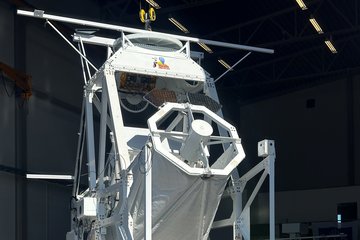All genres
321.
Talk
Introducing the Center for Space Science at NYUAD. Space Science Seminar Series, Abu Dhabi, United Arab Emirates (2015)
322.
Talk
Oblateness of a slowly rotating star from asteroseismology. Kick-off Workshop on "Advances in Seismology: a Dialogue Across Disciplines", Mumbai, India (2015)
323.
Talk
Introduction to the partner group program. Kick-off Workshop on "Advances in Seismology: a Dialogue Across Disciplines", Mumbai, India (2015)
324.
Talk
Solving the forward problem of helioseismology in the frequency domain. The 12th International Conference on Mathematical and Numerical Aspects of Wave Propagation, Karlsruhe, Germany (2015)
325.
Talk
Solar turbulent convection at supergranulation scale. Stellar and Planetary Dynamos, Göttingen, Germany (2015)
326.
Talk
Anisotropy of the solar network magnetic field around the average supergranule. Solarnet III / HELAS VII / SpaceInn Conference, Freiburg, Germany (2015)
327.
Talk
Dynamics of solar supergranulation. Advances in the seismology of the Sun and stars, Mumbai, India (2015)
328.
Talk
Data compression for helioseismology. SOLARNET III / HELAS VII / SpaceInn Conference "The Sun, the stars, and solar-stellar relations", Freiburg, Germany (2015)
329.
Talk
Measuring and interpreting the amplitude of the cross-covariance function of solar seismic waves. Astronomical Society of Japan spring meeting, Osaka, Japan (2015)
330.
Talk
Measurement of the amplitude of the solar cross-covariance function. Solarnet III / HELAS VII / SpaceInn Conference, Freiburg, Germany (2015)
331.
Talk
Simulating acoustic waves in spotted stars. Stellar and Planetary Dynamos, Göttingen, Germany (2015)
332.
Talk
Helioseismology in a Stellar Context: From SDO to PLATO. 18th Cambridge Workshop on Cool Stars, Stellar Systems, and the Sun, Flagstaff, USA (2014)
333.
Talk
Helioseismology with SDO (Highlight). Annual meeting of the Astronomische Gesellschaft, Bamberg, Germany (2014)
334.
Talk
PLATO Data Centre. PLATO 2.0 Science Conference, Taormina, Italy (2014)
335.
Talk
Sounding the Sun and Stars. TIFR Colloquium, Mumbai, India (2014)
336.
Talk
Large Scale Flows. Conference on Coupling and Dynamics of the Solar Atmosphere, Pune, India (2014)
337.
Talk
Trends in theoretical helioseismology. HELAS VI / SOHO 28 / SPACEINN international conference, Göttingen, Germany (2014)
338.
Talk
Sunquakes. DWIH New Delhi - Excellence on Tour 2014, Kolkata, India (2014)
339.
Talk
The PLATO Exoplanet Analysis System - Data Processing Challenges from the Next Generation Planet Hunter. ADASS XXIV: The 24th annual ADASS conference, Calgary, Canada (2014)
340.
Poster
Solar inertial modes: new observations and models. ESRP Meeting, Jena, Germany (2022)










